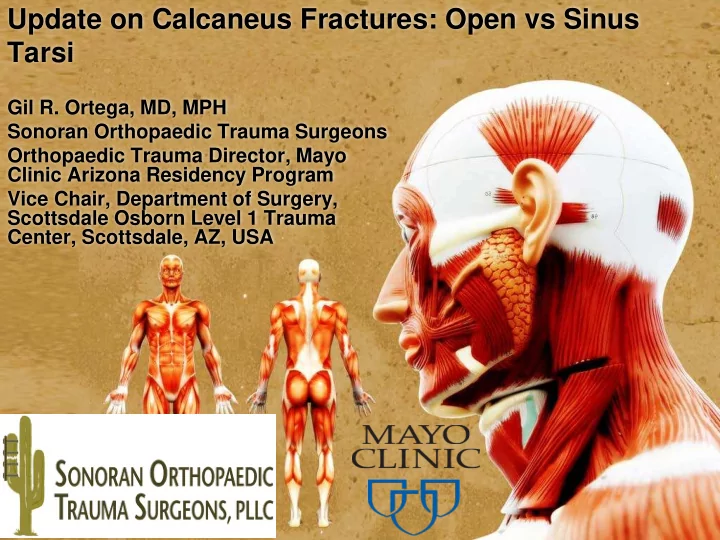

Update on Calcaneus Fractures: Open vs Sinus Tarsi Gil R. Ortega, MD, MPH Sonoran Orthopaedic Trauma Surgeons Orthopaedic Trauma Director, Mayo Clinic Arizona Residency Program Vice Chair, Department of Surgery, Scottsdale Osborn Level 1 Trauma Center, Scottsdale, AZ, USA
Disclosures • Founding Member, Orthopaedic Board of Advisors: Carbofix • Founding Member, Orthopaedic Board of Advisors: Artross Nanobone • Consultant: Smith and Nephew
Why I’ve Used Sinus Tarsi Approach for last 7 years • 4-cm incision over sinus tarsi • Allows for excellent visualization of posterior facet, anterolateral fragment, CCJ, lateral wall, and peroneal tendons • If need be, incision can be extended proxi- mally to treat acute peroneal tendon dislocation • If needed, same incision can be used at later date should subtalar arthrodesis or tendon debridement be indicated
Remember This One Slide and Do the Right Thing for Your Patients…Use the Sinus Tarsi Approach for Most Calcaneus Fractures • Less blood loss • Decreased operative time • Minimization of soft tissue disruption • Fewer wound complications • Higher patient satisfaction scores • Better disability scores than extensile approach
Show You the Evidence… • Retrospective review of 112 operatively treated calcaneus fractures • 79 treated with lateral extensile approach • 33 with sinus tarsi • Significantly lower rate of wound complica- tions – Sinus tarsi group (6%) – Lateral extensile group (29%; P < .005)
Show You the Evidence… • Patients undergoing ORIF via an extensile lateral approach were also more likely to require secondary surgery within the 3-year study period • Importantly, fracture severity was relatively equally distributed among 2 groups • Both groups had 100% union rate
Show You the Evidence… • 2014 randomized, prospective trial by Xia and colleagues • 117 calcaneal fractures were allocated randomly to ORIF via lateral extensile approach versus sinus tarsi approach • All surgeries were performed 8 to 12 days after injury • Significantly decreased operative times in sinus tarsi group compared with extensile group (62 vs 93 minutes) • Lower rate of wound complication (0% vs 16.3%) • Patients in minimally invasive group had significantly higher Maryland foot scores at time of final follow-up • Xia et al. Minimally invasive percutaneous osteosynthesis versus ORIF for Sanders type II and III
Show You the Evidence… • Kwon and colleagues recently conducted a retrospective review of 405 operatively treated calcaneus fractures • Found a decreased overall risk of wound complications with minimally invasive ap- proaches (percutaneous and sinus tarsi techniques) compared with extensile approach • Kwon et al. Effect of Delay to Definitive Surgical Fixation on Wound Complications in the Treatment of Closed, Intra-articular Calcaneus Fractures. Foot Ankle Int. 2015 May;36(5):508-17
Show You the Evidence… • Increased risk of wound complication in Sanders types III and IV fractures treated with minimally invasive approaches compared with Sanders types I and fractures II treated with similar approach (odds ratio, 3.5; 95% confidence interval, 1.3–10.3; P < .018) • Increased risk of wound complication with operative delay beyond 14 days when using minimally invasive approaches (odds ratio, 3.2; 95% confidence interval, 1.3– 9.5; P < .01) • However, these outcomes are of 24 different surgeons with varying degrees of operative experience • Kwon et al. Effect of Delay to Definitive Surgical Fixation on Wound Complications in the Treatment of Closed, Intra-articular Calcaneus Fractures. Foot Ankle Int. 2015 May;36(5):508-17
Show You the Evidence… • Investigate whether sinus tarsi approach (STA) allows for a similar anatomical reduction of the posterior talocalcaneal facet as extended lateral approach (ELA) and compare rate of postoperative wound complications • Incidence of wound complications, time to surgery, postoperative duration of hospital admission, and number of hospital admissions because of wound complications were significantly different between the ELA group and STA group • Tim Schepers, MD, PhD et al Similar Anatomical Reduction and Lower Complication Rates With the Sinus Tarsi Approach Compared With the Extended Lateral Approach in Displaced Intra-Articular Calcaneal Fractures. J Orthop Trauma Volume 31, Number 6, June 2017
Show You the Evidence… • No significant difference in restoration of calcaneal anatomy with either approach • STA was performed in median duration of 105 minutes and ELA in median of 134 minutes, accounting for nearly half an hour difference in operating time (P < 0.001) • Tim Schepers, MD, PhD et al Similar Anatomical Reduction and Lower Complication Rates With the Sinus Tarsi Approach Compared With the Extended Lateral Approach in Displaced Intra- Articular Calcaneal Fractures. J Orthop Trauma Volume 31, Number 6, June 2017
Show You the Evidence… • Systematic review combining results of studies using sinus tarsi approach • Literature search in electronic databases of Cochrane Library and Pubmed Medline, between January 1st 2000 to December 1st 2010, was conducted to identify studies for sinus tarsi approach or modified sinus tarsi approach • Eight case series reporting on 256 patients with 271 calcaneal fractures were identified • Overall good to excellent outcome was reached in three- quarters of all patients
Show You the Evidence… • Average complication rate of minor wound complications of 4.1% was reported and major wound complications in 0.7% • Need for a secondary subtalar arthrodesis occurred at an average rate of 4.3% • Functional outcome and complication rates, of sinus tarsi approach compare similarly or favourably to extended lateral approach • Tim Schepers. International Orthopaedics (SICOT) (2011) 35:697–703
Remember This One Slide and do the right thing for your patients…Use the Sinus Tarsi Approach for Most Calcaneus Fractures • Less blood loss • Decreased operative time • Minimization of soft tissue disruption • Fewer wound complications • Higher patient satisfaction scores • Better disability scores than extensile approach
Thank You
Recommend
More recommend